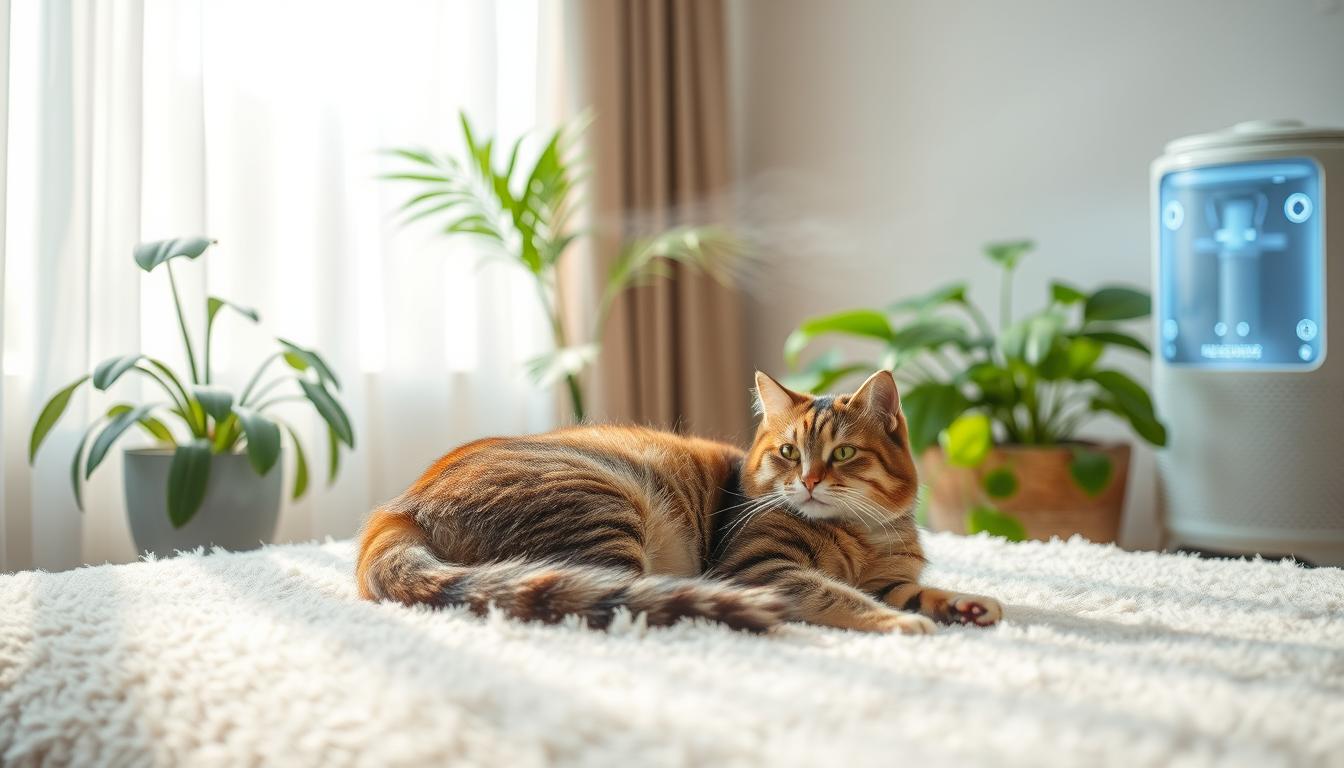As a devoted cat lover, I know how tough it is to deal with cat allergies. Whether you’ve just brought home a new furry friend or have been dealing with allergies for years, I’m here to help. In this guide, we’ll look at ways to make your home allergy-friendly, improve your cat’s grooming, and use air purifiers.
We’ll work together to find a way for you and your cat to live happily, even with allergies.
My own journey with cat allergies has been full of ups and downs. But through lots of research and trying different things, I’ve found ways to manage my symptoms. I’m eager to share these tips with you, so you can enjoy your cat’s company without the sneezing and itching.
Understanding Cat Allergies
Before we can tackle the solutions for managing cat allergies, it’s crucial to understand the underlying causes and common symptoms. Delving into the root of the issue will help us better address and alleviate the discomfort associated with this all-too-common condition.
What Causes Allergic Reactions to Cats?
The primary culprit behind cat allergies is a protein found in a cat’s saliva, skin, and urine. When these proteins are inhaled or come into contact with the skin, they can trigger an immune response in individuals who are sensitive. This immune system overreaction leads to the classic symptoms of cat allergies.
Other factors that can contribute to cat allergies include the following:
- Genetics: Some people are genetically predisposed to developing cat allergies.
- Age: Cat allergies can develop at any age, but they are more common in children and young adults.
- Exposure: Frequent or prolonged exposure to cats can increase the likelihood of developing an allergy.
- Environment: Certain environmental conditions, such as high dust levels or poor air quality, can exacerbate cat allergy symptoms.
Common Symptoms of Cat Allergies
The most common symptoms associated with cat allergies include:
- Sneezing and nasal congestion
- Itchy, watery eyes
- Coughing and wheezing
- Skin rashes or hives
- Difficulty breathing or shortness of breath
These symptoms can range from mild to severe, and they may occur immediately after exposure to a cat or develop gradually over time. Understanding the underlying causes and recognizing the telltale signs of cat allergies is the first step in finding effective solutions to manage this condition and live more comfortably with your feline companion.

Creating an Allergy-Friendly Home
Turning your home into a safe space for those with cat allergies is key. By using smart strategies and making changes, you can cut down cat allergens. This makes your home a more comfortable place to live.
Cleaning well is a big help. Vacuuming carpets, upholstery, and other areas with a HEPA-filtered vacuum catches cat dander and hair. Dusting and wiping down hard surfaces often also helps reduce allergens.
- Invest in high-efficiency particulate air (HEPA) filters for your home’s ventilation system to capture airborne allergens.
- Consider replacing carpeting with hard flooring, which is easier to clean and does not harbor as many allergens.
- Opt for smooth, wipeable surfaces like leather or microfiber furniture instead of fabrics that can trap cat hair and dander.
Air purification is also vital for an allergy-friendly home. Placing air purifiers in important spots can help remove cat allergens from the air. This brings relief to those who are sensitive.
| Feature | Benefit |
|---|---|
| HEPA filtration | Effectively traps 99.97% of airborne particles, including cat dander and hair |
| Activated carbon filter | Removes odors and volatile organic compounds (VOCs) associated with cat litter and grooming products |
| Quiet operation | Allows for continuous use without disrupting your living space |
By adding these allergy-friendly changes, you can make your home more comfortable and breathable. This reduces the impact of cat allergens. It lets you live peacefully with your cat.

Grooming and Bathing Your Cat
Proper grooming and bathing can cut down on allergens at home. As someone with cat allergies, I’ve found that a good grooming routine is key. It helps reduce dander, fur, and other allergens. Plus, it keeps your cat healthy and happy.
Tips for Effective Grooming Routines
Here are some grooming tips to help with cat allergies:
- Brush your cat often (at least 2-3 times a week) to get rid of loose hair and spread skin oils. This cuts down on dander and hair that can make allergies worse.
- Bathe your cat every 4-6 weeks with a gentle, hypoallergenic shampoo. This washes away allergens and keeps their coat clean.
- Wipe your cat’s paws and face with a damp cloth after meals. This removes food residue that can cause allergies.
- Trim your cat’s nails regularly to stop excessive shedding and dander buildup from scratching.
- Vacuum and clean your home often, especially where your cat hangs out. This removes fur and dander.
By following these cat grooming for allergies and bathing cats for allergies tips, you can make your home’s air quality better. This reduces your exposure to cat grooming tips that make your allergies worse.

| Grooming Technique | Frequency | Benefits for Allergy Sufferers |
|---|---|---|
| Brushing | 2-3 times per week | Removes loose hair and distributes skin oils, reducing dander and shedding |
| Bathing | Every 4-6 weeks | Helps wash away allergens and keep the coat clean |
| Paw and Face Wiping | After meals | Removes food residue that can contribute to allergens |
| Nail Trimming | Regular intervals | Prevents excessive shedding and dander buildup from scratching |
| Home Cleaning | Frequent | Removes fur and dander from the environment |
Air Purification Strategies
Investing in a good air purifier can greatly improve your home when you have cat allergies. These devices remove pet dander, dust, and other allergens from the air. This helps allergy sufferers find much-needed relief.
Finding the Right Air Purifier for Your Home
Choosing the right air purifier for your home involves a few important steps. First, consider the size of the room or area you want to purify. Air purifiers work best in specific square footage.
Next, think about the filter type. Some filters are better at catching smaller particles than others. Also, check the noise level. You’ll want an air purifier that’s quiet, so you can enjoy a peaceful home.
Other features like automatic sensors, adjustable fan speeds, and energy efficiency are also important. They can make the air purifier more effective and convenient.
- Determine the size of the room or area you need to purify
- Research filter types and their effectiveness in capturing pet dander and other allergens
- Consider the noise level to ensure the air purifier won’t disrupt your daily activities
- Look for additional features like automatic sensors and energy efficiency
By carefully evaluating these factors, you can find the perfect air purifier. It will help manage air purifiers for cat allergies and make your home more allergy-friendly.
Cat Allergy Solutions: Medication and Immunotherapy
If you have persistent cat allergies, there are solutions to help. Medication and immunotherapy can offer relief. They target the root causes of your allergic reactions, so you can spend more time with your cats.
There are different types of medications for cat allergies. Antihistamines, decongestants, and corticosteroids are among them. Antihistamines like cetirizine and loratadine block the histamine that causes symptoms. Decongestants, such as pseudoephedrine, help with nasal congestion. Corticosteroids, like fluticasone, reduce inflammation and swelling.
Immunotherapy, or allergy shots, is another option. It involves gradually exposing your immune system to cat allergens. This helps your body build up a tolerance over time. It can greatly reduce allergy symptoms, often for good.
- Medications for cat allergies include antihistamines, decongestants, and corticosteroids.
- Immunotherapy, or allergy shots, can help build up your immune system’s tolerance to cat allergens.
- Work closely with your healthcare provider to determine the best treatment plan for your individual needs.
Choosing medication, immunotherapy, or a mix of both is important. Always consult with your healthcare provider to find the best solution for your cat allergies. With the right treatment, you can breathe easier and enjoy your cat’s company more.
Living Happily with Cats Despite Allergies
As a cat lover with allergies, I’ve learned to enjoy life with felines. The right strategies can help you manage your allergies and build a strong bond with your pets. Let’s look at ways to balance your love for cats and your health.
Balancing Your Love for Felines and Your Health
To keep a strong bond with cats while managing allergies, you need a few key steps. Here are some tips to help you live happily with cats despite allergies:
- Establish a Routine for Grooming and Bathing: Regular grooming and baths can cut down on allergens at home. This makes it easier to be around your pet.
- Invest in High-Quality Air Purifiers: Air purifiers can filter out pet dander and pollen. They make your living space more comfortable.
- Explore Medication and Immunotherapy Options: Discuss medication or allergy shots with your doctor. They can help manage your symptoms.
- Consider Adopting a Hypoallergenic Cat Breed: Some breeds, like Siberian and Russian Blue, have lower allergen levels. They might be a good choice for you.
By using these strategies, you can live happily with your cats. You can enjoy their company without hurting your health.
Living with cats despite allergies is definitely doable. With some creativity and effort, you can love your cats and keep your allergies under control. Enjoy the joy of cat ownership and breathe easy, my fellow allergy-prone cat lovers!
Adopting a Hypoallergenic Cat Breed
If your allergies are severe, getting a hypoallergenic cat breed might be a good idea. These cats make less dander, which is better for people with allergies. Here are some top hypoallergenic cat breeds that can be great companions for you.
The Siberian cat is a popular choice because it has less Fel d 1 protein. This protein is a main allergen in cats. These cats shed less and are often a good fit for those with allergies. The Balinese is also a good option. It’s a long-haired breed that makes less dander than many other cats.
The Cornish Rex is another hypoallergenic cat breed worth considering. It has a unique curly coat and sheds very little. The Devon Rex is also a good choice. It has a distinctive look and makes less dander, making it a great low-allergen friend.

